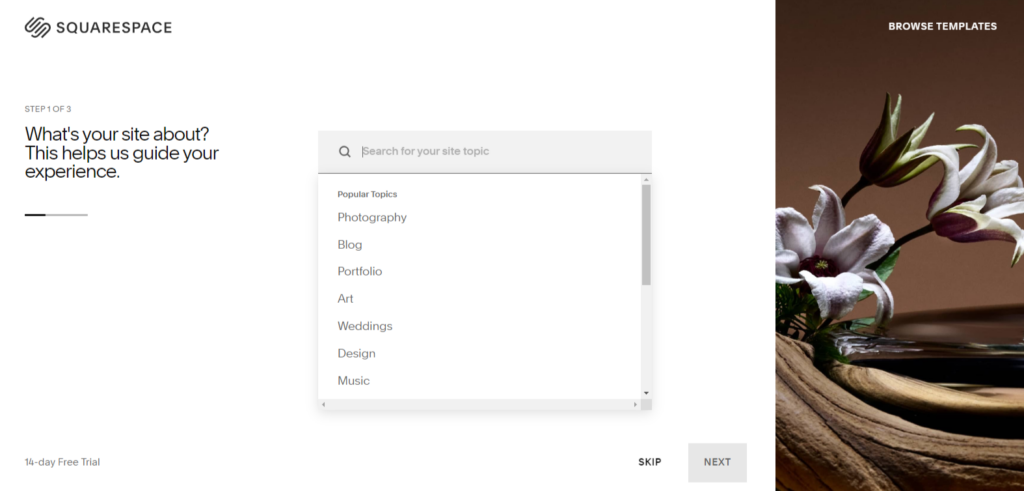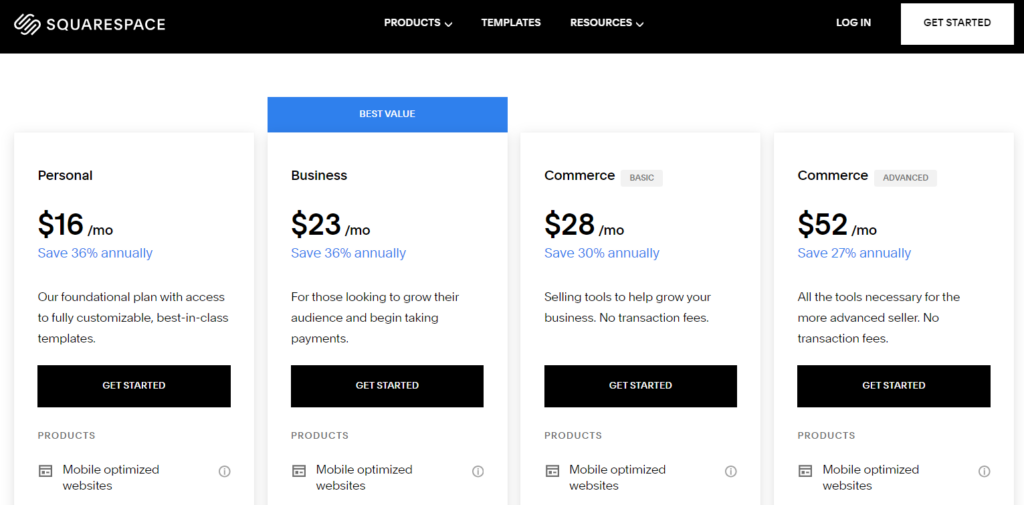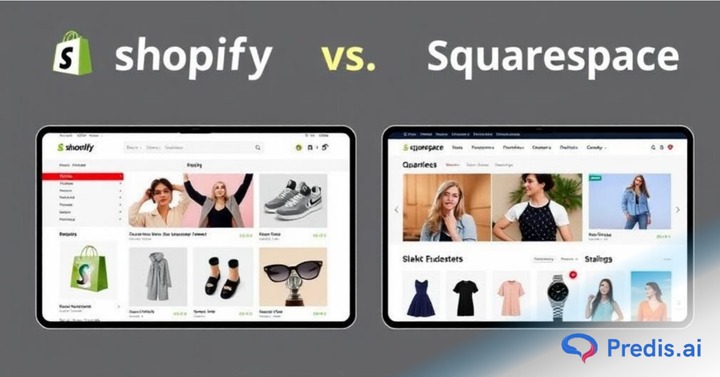In 2023, online shopping saw 31% of users in the U.S., and this rate is predicted to be 24% higher by 2026. This demographic highlights how shopping is now shifting online, and sellers are fast following it for increased product sales.
If you are considering selling your products online to generate increased ROI, platforms like Shopify and Squarespace must have caught your eye.
But what do the brands do, and how are they different? Understanding the Shopify Vs. Squarespace differences can help you decide which platform serves your purpose better, and you can make a better decision.
Shopify Vs. Squarespace: What do The Two Platforms Do?
Squarespace is predominantly a website-building platform that has product-selling options. It is an all-in-one platform that started off with the major goal of letting users build a content-driven website. On the other hand, Shopify features initially centered on providing a shop for users to sell their products online.
This is the first thing that you need to keep in mind when looking at the two; that they have distinct interfaces with different functionalities. Shopify’s focus point is on selling products and Squarespace limelight website building. This major difference can have a significant effect on any seller’s online shop.
Below, let us discuss Shopify’s different features and price models and compare them to Squarespace’s features and pricing models for enhanced clarity on the matter.
Shopify Vs. Squarespace: Differences in Key Features
Shopify and Squarespace offer distinct features that help marketers in different ways. Let us discuss the Shopify vs. Squarespace differences below so that you can figure out which one you want to use in your shopping strategy.
Setting up
- Shopify
Shopify has a more in-depth sign-up process as compared to Squarespace because it focuses on learning the different business goals of every company and allowing them to sell accordingly. You will find questions on the website on starting the free trial about what you want to sell and how it is that you plan to sell these products.

This ensures that the platform modifies the Shopify features so that it can serve every seller according to their marketing goals. Even if you are just starting, Shopify offers a range of marketing options to allow your shop to thrive.
- Squarespace
Squarespace has a fairly simple sign-up process and is quite different from Shopify. The first step of using the platform involves choosing a template for your website after specifying the type of services you provide.

Once you specify the genre you are working with, the platform will ask what you want to use your website for: do you want to sell services, promote an event, or build a community?
The Shopify vs. Squarespace setup processes show how different the two platforms remain, even though they have started using similar interfaces over the years to keep up with rising competition.
SEO Tools
SEO is a significant marker of any shopping platform, and both platforms have different ways of approaching the topic.
- Shopify
Shopify aims to meet the requirements of Core Web Vitals of Google and offers different SEO tools that help brands improve page loading time and responsiveness of their websites. The platform offers tools for tag generation to prevent duplicate pages, meta titles, descriptions, and SEO URLs.
Users can browse through the suggestions of the platform and modify meta titles and descriptions for better results.
- Squarespace
Squarespace features include the same type of SEO tools as Shopify, but the platform has limited tools. Users can modify meta titles and descriptions, but the platform does not offer them suggestions like Shopify.
In addition, all Squarespace plans include Google Analytics, which helps users track their progress and measure ROI to understand the success of their advertising campaigns.
If your brand is looking for a platform that offers good overall SEO integration, Shopify may be your best shot because it offers suggestions and covers many facilities.
Marketing Tools
- Social Media
In 2023, 67% of marketers were using Facebook ads, and Instagram ranked second at 55%. The marketing assistance and blogging facilities of Shopify Vs. Squarespace allows marketers to use this power to expand their audience with social media posts and SEO-enriched blogs.
- Shopify
Marketers can sell their products using Shopify on different platforms like Facebook, Instagram, TikTok, Twitter (X), and Pinterest without using any other third-party application. Moreover, you can use Shopify to integrate tools that allow pop-ads, forms, reviewing, and different customer programs.
Shopify features allow a seamless social media experience after you decide on the budget of your campaign. Marketers can access shop management tools for customer servicing and merchandising and come across new apps to sell their products.
Third-party app integration is the building block of Shopify marketing and applications like Oberlo, Easy Digital Products, and TaxJar are great to allow marketers easy selling across various platforms.
- Squarespace
Squarespace offers limited social media assistance, as compared to Shopify. Brands can advertise on Facebook, Instagram, and LinkedIn but these are just about the only social media assistance that the platform offers.
Squarespace features provide a different marketing approach because they focus on first-party integration, as compared to Shopify’s third-party application focus. These in-built applications cover just as much ground as the third-party applications that Shopify offers.
Shopify can be a better option for social media marketing and marketing using the platform because it has some great third-party integrations. However, it is important to keep in mind that these applications often require subscriptions and may cost more for companies.
Email Marketing
81% of companies use email marketing in their marketing strategy to generate higher conversion rates by engaging customers closely. Here are the main Shopify Vs. Squarespace email marketing differences.
- Shopify
Shopify and Squarespace offer similar email marketing services, but their distinctiveness kicks in because of the basic differences in functionality of the two platforms. Shopify offers templates based on on-site design, and the platform also uses different templates for holidays and other such days.
- Squarespace
But, it is Squarespace that beats Shopify when it comes to email marketing. Squarespace focuses on how your business looks and suggests templates according to that. You find different ways of customizing your emails and there are added options to add new graphic elements to your emails like pictures, icons, and logos.
Website Content and Templates
A well-designed interface can boost conversion rates by 200% and thus, website templates become crucial for any business. Here are some Shopify vs. Squarespace template differences:
- Shopify
Shopify offers a fairly limited range of templates, and they all cost money. Ten to fifteen templates are free, and the rest require one-time payments.

These templates allow you to edit sections and create a unique interface for your website. However, they offer limited customization because there is no drag-and-drop editor. Users can change fonts, tweak the color palette, and play with logos and icons.
- Squarespace
Squarespace offers up to 250 templates for different website aesthetics and services. These templates are free to use and can be a great option for people looking for beautiful websites that cater to the aesthetics of your business.

Squarespace has a more responsive interface that works well for small companies looking to optimize their websites for their customers. The website offers many different facilities, like a 360-degree view of products, and it also has the drag-and-drop editing option that Shopify lacks.
Thus, the Squarespace and Shopify features have similarities but diverge at crucial points. Shopify serves the purpose of bigger enterprises that need its marketing tools and cannot forego them. Squarespace is a great option for small businesses as it offers different accessibility options that may benefit from the advanced graphic design of their website, but those seeking a more tailored solution might consider a Squarespace alternative.
Dropshipping
Dropshipping has fulfilled 23% of all online purchases and its market is supposed to reach $476.1 billion in 2026. Most marketers use the two platforms to ship products globally for an increased reach. Here are some Shopify vs. Squarespace differences when it comes to shipping facilities.
- Shopify
Shopify features, as discussed above, allow better third-party services for e-commerce stores. The platform has label printing services and other third-party shipping facilities with USPS, UPS, and DHL. that may benefit large enterprises but may not be required by small businesses.
With around 500+ brands offering dropshipping at Shopify, there is an app out there that meets your company’s standards and allows you to sell your products globally and make dropshipping ads effortlessly. You get better-discounted rates with Shopify with the third-party apps and the platforms it uses for shipping.
- Squarespace
Squarespace features have similar shipping options but the platform uses in-built shipping facilities. The shipping facilities are pretty limited, as compared to Shopify but Squarespace does use USPS, UPS, and FedEx for real-time shipping services. The shipping rates with Squarespace are not as discounted as with Shopify.
In recent years, the platform has seen significant growth and now has better shipping facilities with more third-party integrations from Shiprocket and ShipBob, allowing more options for marketers who want to use the platform for drop shipping.
Thus, when it comes to shipping, Squarespace has a long way to go, and Shopify wins square and fair. The Shopify vs. Squarespace differences here mean that marketers can use the former to sell a considerable amount of products, but the latter still needs to work on scalability.
Shopify Pricing Vs. Squarespace Pricing
Perhaps the biggest Shopify vs. Squarespace difference lies in the price point. The two platforms offer various price points depending on the marketing demands of any company. Let us look at the pricing models below.
- Shopify
Shopify pricing offers four different models, as mentioned below:
- Shopify Basic: $29/month
- Shopify Business: $79/month
- Shopify Advanced: $299/month
- Shopify Plus: $2,300/month
It is essential to note that Shopify does not offer free plans to users, so if you do plan on choosing Shopify, you will always have to pay a fee. The Basic account offers four product locations for easy management and shipping, and you get two business accounts with it. The Business account, which comes under the $79 Shopify shipping charges, offers an extra account and gives shipping discounts.
With the Advanced account, you get 15 accounts and 8 storage locations for your products, which works well for big companies. The Shopify pricing for Plus is significantly large and stands at that because it is built for large-scale enterprises.
In addition, you need to pay for the website templates, which can be anywhere between $140 and $400. The third-party apps that your brand uses will also cost you according to the services and size of your company.
- Squarespace
Compared to the Shopify pricing models, Squarespace pricing is pretty affordable and comes in the following price points:
- Personal: $16/month
- Business: $23/month
- Commerce Basic: $28/month
- Commerce Advanced: $52/month
The Personal plan does not offer e-commerce facilities but works well for a personal website. The Business plan has e-commerce functionality but charges a 3% transaction fee, which can become considerable when you consider large amounts.
The Commerce Basic is perhaps the best Squarespace pricing model with e-commerce facilities and zero transaction charges. Additionally, you get full control over your website and an email account. The Commerce Advanced is a great option for companies that want to sell subscriptions and offer advanced shipping options, which works well for big companies.
Looking at the Shopify and Squarespace pricing models, it becomes clear that the Squarespace one works well for smaller companies, while the Shopify pricing models are good for big companies that can afford to invest more in their advertising and shipping plans.

Shopify Vs. Squarespace: Which One Should You Use?
The Shopify vs. Squarespace debate cannot end with a simple solution that is better than the other. The two have different functions, and understanding these differences is crucial to making a well-informed decision. While Squarespace offers a simple content-heavy website-building solution, Shopify focuses on providing selling solutions.
You must clearly understand what you need for your business and which of these models works better for your purposes. Analyze the different Shopify and Squarespace features and the different ways in which the two offer to increase organic growth with social media advertising.
Do you want a successful marketing tactic that helps your brand transcend in the social media world? Use the power of Predis.ai and its social media tools today. The brand helps companies track progress, analyze their growth, and generate original content that grabs the audience’s attention.
Sign up today for a free demo and grow your brand today!
You may also like,
Learn to Link Instagram with Squarespace – Complete Guide















